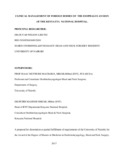| dc.contributor.author | Ouyah, Wilson L | |
| dc.date.accessioned | 2017-12-14T06:14:20Z | |
| dc.date.available | 2017-12-14T06:14:20Z | |
| dc.date.issued | 2017 | |
| dc.identifier.uri | http://hdl.handle.net/11295/101865 | |
| dc.description.abstract | Foreign bodies of the esophagus are common at the Kenyatta National Hospital with an increasing number of lithium disc batteries being seen. A local study showed two peak ages of patients with esophageal FBs, those below 6 years (59.3%) and adults at 23.7%.
In the United States, there are over 100 000 cases of esophageal FBs per year. In 80–90% of these cases, the FB passes spontaneously through the GIT while the remainders lodge in the esophagus and need to be removed.
Study objective: To determine the clinical presentation and management of FBs of the esophagus at the KNH.
Study design & setting: Hospital-based descriptive cross-sectional study, the setting being at the KNH A&E and ENT departments
Methodology:A total of 100 cases were recruited and a detailed history of the type of FB, presenting signs and symptoms, modes of management and complications were recorded.
Statistical Analysis:
Data analysis was conducted using SPSS (version 20). The bivariate analysis was based on calculation of Pearson’s chi square test and statistical significance was based on a p value cut off of 0.05.
Significance of the study:
This study aimed at providing information on the local patterns of esophageal FBs, modes of management and complications.
Results
This study shows that the mean age of patients with FB esophagus is 6 years with a range of 9 months to 60 years. A large proportion of the patients are referrals (69%) and 31% of the patients presented directly to KNH. Coins form the largest proportion of FBs in the esophagus (77.2%), bones (9.9%), and lithium disc batteries (8.9%). A median duration of 24 hours is observed from ingestion to presentation with a higher proportion of the patients (32.7%) presenting after 2 days. Rigid esophagoscopy is used in 55% of the cases, Mackintosh laryngoscope and Magill forceps (44%) and flexible endoscopy (1%).Complications occur at a rate of 5% and lithium disc batteries are associated with the highest rates of complications (11.1%).Mortality occur at a rate of 1%.
Conclusion
This condition affects mainly the paediatric population with a mean age of 6 years. Coins and lithium disc batteries are common in the paediatric population, with bones being prevalent in adults. Lithium disc batteries cause the highest rates of complications and mortalities occur from the condition.
Recommendations
There should be proper disposal of the lithium disc batteries and a study on their long term complications is recommended. | en_US |
| dc.language.iso | en | en_US |
| dc.publisher | University of Nairobi | en_US |
| dc.rights | Attribution-NonCommercial-NoDerivs 3.0 United States | * |
| dc.rights.uri | http://creativecommons.org/licenses/by-nc-nd/3.0/us/ | * |
| dc.subject | Clinical Management of Foreign Bodies of the Esophagus | en_US |
| dc.title | Clinical Management of Foreign Bodies of the Esophagus as Seen at the Kenyatta National Hospital. | en_US |
| dc.type | Thesis | en_US |
| dc.description.department | a
Department of Psychiatry, University of Nairobi, ; bDepartment of Mental Health, School of Medicine,
Moi University, Eldoret, Kenya | |



